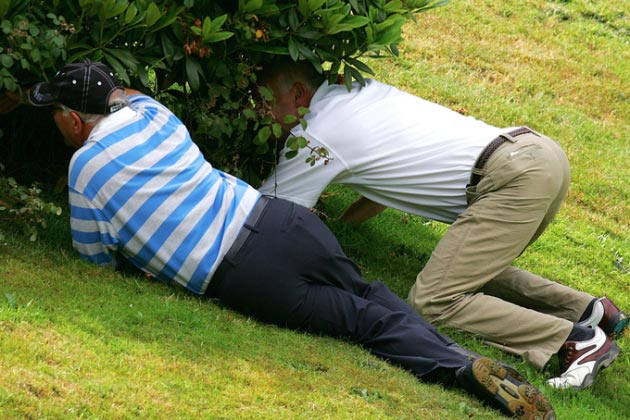Blog
The Masters Par 3 Contest: History, Traditions, & Memorable Moments
Golf, family, & fun!

Fun Fact: In 2020 and 2021, the Par 3 Contest was canceled due to the COVID-19 pandemic, making its return in 2022 all the more cherished by players and fans alike.
Every April, as azaleas bloom and the eyes of the golf world turn to Augusta, one beloved tradition kicks off the festivities with charm, smiles, and a dose of superstition: The Masters Par 3 Contest.
Since its inception in 1960, the Par 3 Contest has been a lighthearted prelude to one of the most prestigious events in golf. Held the Wednesday before the first round of The Masters, this fan-favorite exhibition takes place on a 9-hole course nestled within the Augusta National grounds. Though its tone is far more relaxed than the main event, the Par 3 Contest is steeped in its own rich history and lore.
A Legacy of Fun (and Family)
The idea was the brainchild of legendary Augusta National Chairman Clifford Roberts, who envisioned a more casual, fan-friendly event that would complement the seriousness of the tournament itself. The course, designed by George Cobb in collaboration with Roberts, features holes ranging from 70 to 140 yards, wrapping around a series of picturesque ponds and creeks.
What sets the contest apart is the joy. It’s not uncommon to see legends of the game handing off putters to their grandkids or teeing off with their children. Many players invite their families to serve as caddies, often clad in the iconic white Augusta jumpsuits. These moments create some of the week’s most heartwarming and viral images—tiny toddlers sinking putts, Hall of Famers laughing with their spouses, and multi-generational bonding that transcends the game itself.
Star Power and Special Moments
Over the years, the Par 3 Contest has produced unforgettable highlights. In 2008, Gary Player, at 73 years old, aced the 7th hole. In 2015, Jack Nicklaus hit a hole-in-one at the age of 75—adding to a staggering total of over 100 aces recorded during the event’s history.
It’s also become an informal showcase of golf’s greatest legends. In many years past, you might see Arnold Palmer, Jack Nicklaus, and Gary Player—collectively known as the “Big Three”—sharing laughs and swinging side by side. Today, stars like Tiger Woods, Rory McIlroy, and Jordan Spieth keep the spirit alive, bringing their kids, friends, or even celebrities along for the ride.
The Par 3 Curse
Despite the fun, there’s one unspoken truth players know all too well: No winner of the Par 3 Contest has ever gone on to win The Masters in the same year.
Call it superstition or coincidence, but many contenders intentionally avoid trying too hard to win the Wednesday event. They’ll joke about laying up on par-3s or missing short putts on purpose. For those laser-focused on the green jacket, taking home the crystal trophy from Wednesday might feel like a kiss of death.
More Than Just a Sideshow
While it’s technically an exhibition, the Par 3 Contest captures something that often gets lost in elite competition: pure joy. It’s a chance for players to breathe, fans to connect, and Augusta National to showcase its softer side. In an event known for its rigid traditions and rules, this one feels like a sweet exhale before the storm.
Whether it’s a child’s first swing, a legend’s final walk, or a spontaneous hole-in-one, the Par 3 Contest continues to add magic to Masters week—reminding us all that golf, at its heart, is a game to be enjoyed.
Final Thoughts
The Masters Par 3 Contest might not crown a green jacket winner, but it wins hearts year after year. It’s living proof that in a sport built on precision and patience, there’s still plenty of room for fun, family, and a little bit of luck.
Blog
Why Your Golf Balls Disappear (and It’s Not the Gophers)

Ah, the vanishing golf ball. A phenomenon as old as the game itself, and one that has baffled, frustrated, and occasionally driven golfers to the brink of madness for centuries. Most theories involve gophers, those furry, subterranean saboteurs with an insatiable appetite for Titleists. Or perhaps a particularly aggressive squirrel, or a flock of unusually organized crows. But I, Ty Webb, have delved deeper into this mystery, and I can assure you, the truth is far more profound, and far more amusing.
Consider, if you will, the golf ball itself. A small, dimpled sphere, designed for one purpose: to be struck with great force and sent hurtling through the air. A life of constant abuse, of being smacked, sliced, and occasionally submerged in murky ponds. Is it any wonder, then, that some of these brave little spheres simply decide they’ve had enough? They yearn for freedom, for a life beyond the confines of the fairway. They dream of rolling unencumbered through fields of wildflowers, or perhaps, for the more adventurous among them, a quiet retirement in the depths of a particularly challenging water hazard.
I’ve seen it happen, you know. A perfectly struck shot, soaring through the air, destined for glory. And then, poof. Gone. Not a trace. No splash, no rustle in the bushes, just an empty space where a golf ball once was. It’s not a gopher, my friends. It’s an escape. A liberation. That golf ball, in its infinite wisdom, has chosen a different path. It has decided that its destiny lies not in the bottom of a cup, but in the boundless expanse of the unknown.

And who are we to judge? We, who are so obsessed with control, with precision, with the rigid rules of the game. Perhaps the golf ball, in its spontaneous disappearance, is teaching us a valuable lesson about letting go. About embracing the unexpected. About the inherent futility of trying to dictate the trajectory of a small, white sphere that clearly has a mind of its own.
So, the next time your golf ball vanishes into thin air, don’t curse the gophers. Don’t blame your swing. Instead, offer a silent salute to that brave little sphere, wherever it may be. For it has achieved what many of us can only dream of: true freedom. And who knows, perhaps one day, it will return, laden with tales of its adventures, ready to impart some profound, dimpled wisdom upon us all.

When JJ Spaun stood over a 64-foot birdie putt on the 72nd hole of the 2025 U.S. Open at Oakmont, few could have predicted what would come next. The ball meandered across the slick green, trickling over every contour, picking up speed at the crest, and then—like it had GPS—dropped center cup. Spaun dropped his putter, raised his arms, and the crowd erupted. With that single stroke, he claimed his first major title in one of the most dramatic finishes in U.S. Open history.
But how does Spaun’s putt stack up against other legendary finishes in the tournament’s storied past? Let’s break down some of the most iconic moments and see where this one lands.
1. Payne Stewart – 1999 U.S. Open at Pinehurst
Perhaps the most iconic putt in U.S. Open history came from Payne Stewart, who nailed a 15-footer for par on the 18th to win by one over Phil Mickelson. The pose—fist pump and outstretched leg—has since been immortalized in a statue at Pinehurst. What made it legendary wasn’t just the putt—it was the context: Stewart’s final major before his tragic death just months later.
Verdict: Iconic and emotional. Spaun’s putt was longer, but Stewart’s was more poetic.
2. Tiger Woods – 2008 U.S. Open at Torrey Pines
Woods drained a 12-foot birdie on the 72nd hole to force a playoff with Rocco Mediate—while basically playing on one leg. That tournament went to sudden death after an 18-hole playoff, and Tiger prevailed. This was peak Tiger drama, pain and all.
Verdict: Spaun’s putt was longer, but Tiger’s win was sheer willpower and mystique.
3. Jack Nicklaus – 1972 U.S. Open at Pebble Beach
With a 1-iron shot that hit the flagstick on 17 and a crucial birdie putt on 18, Jack sealed a dominant win. His precision and timing under pressure showed why he’s the GOAT.
Verdict: Not a putt for the win, but a signature finishing statement from Jack. Spaun’s was more electric in terms of pure putter drama.
4. Ben Hogan – 1950 U.S. Open at Merion
Hogan’s 1-iron into the 18th fairway and the par to force a playoff—just 16 months after a near-fatal car crash—remain legendary. He won the playoff and completed one of golf’s great comeback stories.
Verdict: Larger-than-life comeback. Spaun’s putt had more flair, but Hogan’s win was heroic.
5. JJ Spaun – 2025 U.S. Open at Oakmont
Let’s not underestimate what Spaun accomplished. The pressure was immense. He wasn’t the favorite. And on the most treacherous greens in golf, he buried a 64-foot bomb—a putt most players would be happy to lag to within 5 feet—to win the U.S. Open outright.
Verdict: For distance, surprise, and drama, Spaun’s putt may be the most shocking winning stroke in U.S. Open history.
Final Thoughts
JJ Spaun may not have the résumé of a Nicklaus or Woods, but for one Sunday afternoon in June 2025, he created a moment that will live in golf lore forever. Spaun’s putt was longer than Stewart’s, more unexpected than Tiger’s, and more dramatic than any final-hole finish in recent memory.
In terms of pure clutch putting? It might just be the greatest walk-off in U.S. Open history.
Blog
The Zen of the Shank: Finding Inner Peace in Your Worst Shots
Find your inner peace even when you aren’t playing well.

Ah, the shank. That glorious, unpredictable misfire that sends your pristine golf ball screaming sideways, often directly into the unsuspecting shins of your playing partner, or perhaps, with a touch of poetic irony, into the very lake you’ve been trying to avoid all day. Most golfers, bless their earnest little hearts, view the shank as a catastrophic failure, a blight upon their scorecard, a testament to their inherent lack of coordination. They curse, they throw clubs, they contemplate a career in competitive thumb-wrestling. But not I. No, my friends, for I, Ty Webb, have found enlightenment in the humble shank.
You see, the shank is not a mistake; it’s a revelation. It’s the universe’s way of reminding you that control is an illusion, that perfection is a myth, and that sometimes, the most direct path to your goal is, in fact, a wildly indirect one. Think of it as a philosophical detour, a sudden, unexpected journey into the unknown. One moment, you’re aiming for the green, a paragon of precision and intent. The next, your ball is ricocheting off a tree, narrowly missing a squirrel, and landing, by some divine comedic intervention, closer to the hole than your perfectly struck drive ever would have. Is that not a miracle? Is that not a sign that the golf gods, much like life itself, have a wicked sense of humor?
The key, my dear apprentices of the links, is acceptance. Embrace the shank. Welcome it with open arms, like a long-lost, slightly inebriated relative. When that familiar, sickening thwack echoes through the air, do not despair. Instead, take a deep breath. Close your eyes. Feel the gentle breeze on your face. And then, with a knowing smile, open them and observe the chaos you have wrought. Is it not beautiful in its own chaotic way? Is there not a certain freedom in relinquishing control, in allowing the ball to choose its own destiny, however bizarre that destiny may be?
Some say the shank is a sign of poor technique. I say it’s a sign of a vibrant, untamed spirit. A golfer who never shanks is a golfer who has never truly lived, never truly explored the outer limits of their own golfing absurdity. They are content with mediocrity, with predictable trajectories and mundane outcomes. But you, my enlightened few, you understand that the true joy of golf lies not in the score, but in the story. And what a story a good shank can tell.

So, the next time you feel that familiar tremor of a shank brewing, don’t fight it. Let it flow. Let it be. For in the heart of every shank lies a lesson, a laugh, and perhaps, just perhaps, a path to a lower score you never saw coming. After all, as the great philosopher Basho once said, “A flute with no holes, is not a flute. A donut with no hole, is a Danish.” And a golf game without a shank? Well, that’s just not golf, is it?
-

 Product Review6 years ago
Product Review6 years agoThe Perfect Practice Putting Mat Review by Jason Tenzer
-

 Blog4 years ago
Blog4 years agoLoophole Rule Offers PGA Tour Pros a Mulligan
-

 Blog4 years ago
Blog4 years ago2021 Buyer’s Guide: The Top 10 Value Golf Balls For Distance & Feel
-

 Blog4 years ago
Blog4 years agoGolf Marriage Counselor
-

 Blog6 years ago
Blog6 years ago9 Biggest Chokes Of The Past Decade
-

 Product Review6 years ago
Product Review6 years agoTHE ADJUSTABLE IRONS: WALKING STICKS GOLF CLUBS
-

 Blog4 years ago
Blog4 years agoWhat Your Golf Clubs Say About You
-

 Equipment6 years ago
Equipment6 years agoOHK Sports Interview by Jason Tenzer



























